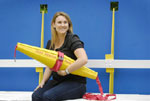A new self-fitting neck brace has been developed by a Queensland University of Technology designer to help prevent spinal injuries when people are rescued from the ocean.
Postgraduate industrial design student, Anna Jacobsen, said that unlike traditional neck braces, her design - called ResQ - could be fitted to accident victims before they are brought to shore and could be used by a rescuer without extra specialist training.
Jacobsen said: 'Lifesavers have a lot of equipment to assist patients out of the water, but there is currently no equipment for moving a patient in the water.
'If a spinal injury is suspected, often the lifesaver must wait in the wash zone [where waves break on the shore] until more help arrives.
'This wash zone can agitate the patient's condition and result in further injury.
'Also, injuries can happen as the person is being transported out of the water.'
Jacobsen, who comes from a family of lifesavers, has designed the neck brace to fit around a modified lifesavers' tube, a yellow flotation device commonly used to float people in the surf.
She said: 'The neck brace consists of two rings, which individually clip around the neck of the patient and can be adjusted to suit a wide variety of beach goers.'
Joining the two rings together is an inflatable bladder, activated by pulling a toggle at the back of the brace, which inflates to support the neck in a similar manner to an inflatable life vest.

Jacobsen said the inflating bladder took away the need for the rescuer to have specialised training, as is required for the use of existing neck braces.
She also believes that the modified tube and neck brace could be produced more cheaply than the existing equipment used by lifesavers.
The device still requires medical testing, which could be undertaken with commercial support.




Collaboration to address viable solutions for VAWG database
<blockquote>address the lack of standardisation, coordination, and collaboration of gender disaggregated data intelligence across various regions,...